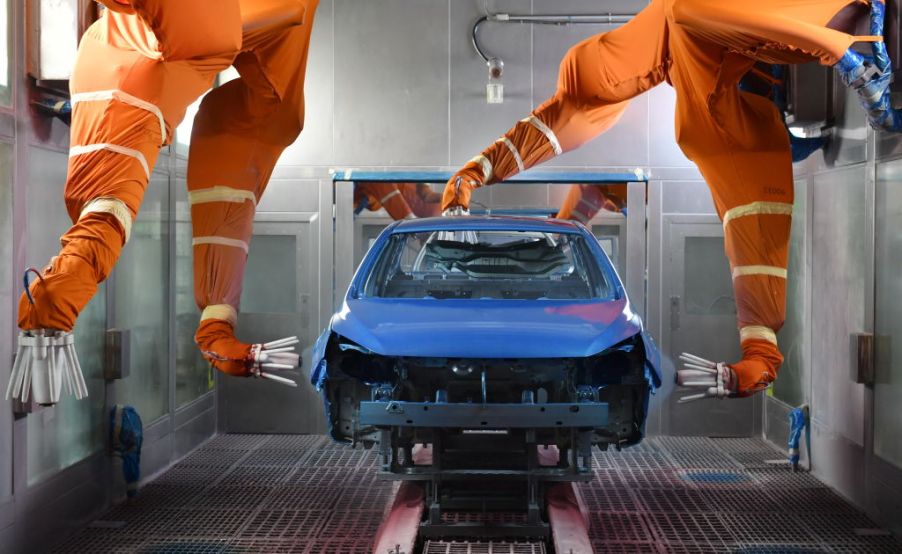
The Reason Why Some Car Paint Colors Command a Premium
Although automotive paint technology has improved over the years, improper care can still cause damage to your car’s paint. Also, automaker quality problems still pop up from time to time. And then there’s the cost of choosing your car’s paint color. Not only can this affect resale value, some colors can be rather expensive. True, you can always wrap your car to change its looks on the cheap. But is there a reason why some car paint colors cost more than others?
How car paint colors get developed
I used to work as an automotive paint engineer. I worked with color development personnel to make sure our automaker clients got their cars painted the way they wanted. And making new colors wasn’t easy; the process takes years. One extreme example is Lexus, which took 15 years to develop its Structural Blue paint, Jalopnik reports.

Part of that is down to what goes into modern car paint. It’s not just pigment, but also binders that harden the paint, and solvents and additives to help the paint dry and flow, Hot Rod explains. There are also metallic flakes, the Automotive Paint Handbook explains, for added sparkle. And that’s just for color and appearance.
According to Consumer Reports, modern car paint colors are expected to last at least 10 years. After a color gets developed, it’s sprayed on test panels, and sent to facilities in South Florida. There, the panels bake for years in the hot sun, surrounded by humid, salt-filled air. Technicians also pelt test panels with gravel, scratch them with knives, and perform various other tests to check for durability. All this takes time and money.
But, as BASF explains, car paint color depends on more than just the pigment.
What affects car paint color?
Car paint color is influenced by a variety of factors. Look at the same car at two different times of day, or two different angles, and the color changes. The color also depends on how thick the paint is, and what’s underneath it, like the rust-protecting e-coat and primer. There’s also the protective clear coat, which isn’t always actually clear.
Because of all these variables, paint inspectors use expensive and sensitive instruments to gauge a car’s paint color. This instrument is put on a random car in the line, and a special light shines on a specific section. This light source moves, bouncing light at different angles into a sensor. The color and sparkle data are then compared to a known standard. If it’s too far off, the car has to be re-painted.
But, with all this technology to test and develop paint, why does it seem like most modern cars all seem to be painted silver?
Automotive paint trends and costs

True, not every car on the road is silver, white, or black. For example, the Toyota 86 Hakone Edition comes in a deep shade of green. However, according to Motor1, 38% of new car buyers opted for white. 19% chose black, and 13% chose grey. White, black, grey, and silver accounted for 80% of all car paint colors in 2019. And, as Donut Media explains, there are a few reasons for that.
One is simply down to trends. White and silver are trendy now, and black basically never really goes out of style. In addition, right now is a time of economic uncertainty. Generally speaking, when people buy cars in times like these, they’re not going for flashy, expensive ones. So, they don’t pick loud car paint colors, unless they’re buying an expensive luxury car or supercar. And the economic motivation goes further than that.

Because white, silver, and black are so popular, cars with these paint colors have stronger resale values. There are also generally more white, black, and silver cars available on the lot than any other color. People don’t have a lot of free time, so when they go car-shopping, they’ll tend to pick from whatever’s available that day.
Furthermore, white, silver, and black tend to be the default, no-cost color options for most cars. To get a Mazda CX-5 in the brand’s signature Soul Red costs $595. And if you want a Tesla Model 3 in red, it’s an extra $2000. And, unfortunately, that’s built into the paint itself.
Why do some colors cost more?
Although Mazda also offers a special Pearl White for an added cost, generally speaking, white, black, and silver automotive paint is almost always going to be cheaper then red, blue, or green paint. Especially if it’s metallic paint.
Firstly, a non-metallic paint doesn’t have flakes. So, non-metallic white and black paint is automatically going to be cheaper than a metallic paint.
Secondly, colored paints need pigment. Silver paint, though, is basically all metal flake. It’s not necessarily as cheap as plain black paint, but all the ‘color’ comes from the flake. No pigment means no additional cost. Also, some pigments just cost more, especially red and yellow, CR reports.

Finally, some of the richest paint shades need multiple coats to look that way. That adds time and complexity to the production line, which adds cost. It also adds more opportunities for defects to appear, which adds even more time and cost.
If you want a flashy car paint color, be prepared to pay for it.
Follow more updates from MotorBiscuit on our Facebook page.


